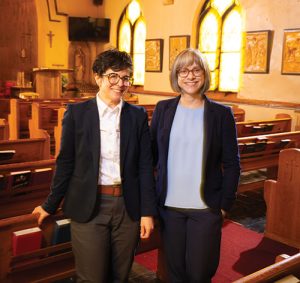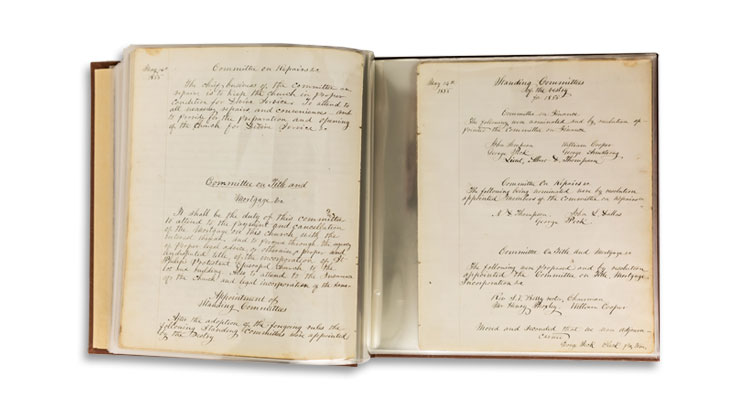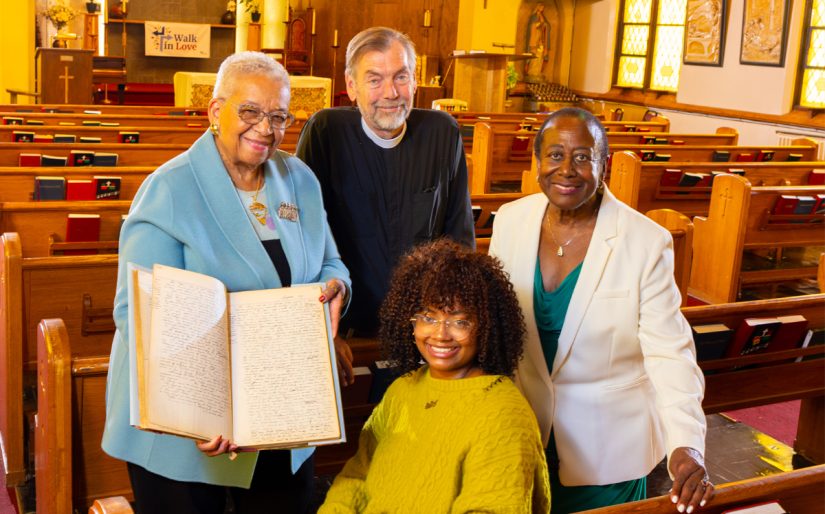St. Philip’s Episcopal Church Records Find a Home in the University Archives
The University Archives recently received a significant addition to their collection: a series of ledgers and documents from St. Philip’s Episcopal Church in Buffalo, N.Y., one of the oldest African American Episcopal congregations in the country. These records, dating back to the mid-19th century, are now preserved and accessible both digitally and physically, serving as a vital records repository for the community.
St. Philip’s Episcopal Church, established in 1861, holds a prominent place in Buffalo’s history as the first Black Episcopal church in the area. This newly acquired collection includes early minute books, as well as baptism, marriage, and burial records dating back to the church’s founding. providing a comprehensive look into the lives and milestones of the congregation over the years, offering invaluable insights into the social, cultural, and religious history of Buffalo’s Black community.
The journey that led to the University Archives being entrusted with the conservation and care of these historical records goes back many years and involved input and cooperation from various community members and historians. Dr. Lillian S. Williams, an associate professor in UB’s Department of Africana and American Studies, was instrumental in ensuring the preservation of these materials. In the late 1970s, as part of the Afro-American Historical Association of the Niagara Frontier, Dr. Williams had the records microfilmed and deposited at Buffalo State College, with the original documents returned to St. Philip’s Episcopal Church.
Years later, during the COVID-19 pandemic, Dr. Barbara Seals Nevergold, a historian and co-founder of the Uncrowned Queens Institute for Research & Education on Women, revisited the St. Philip’s records as part of her research of Buffalo’s earliest Black churches. Recognizing the fragile state of the materials, Dr. Nevergold, who had firsthand knowledge of their condition, sought to ensure their long-term preservation. She, along with Dr. Williams, approached the University Archives about safeguarding the records for posterity, emphasizing the importance of maintaining accessibility for both the congregation and the broader community.

Marie Elia and Sarah Cogley
In 2021, UB Interim Co-University Archivists, Sarah Cogley and Marie Elia, met with Dr. Nevergold, Dr. Williams, Pastor Steve Lane of St. Philip’s Episcopal Church and Josephine Cross, a senior warden of the church, to discuss the St. Philip’s significance and the broader role of Black churches in Buffalo. Pastor Lane supported the idea of donating the records to the University Archives, which proposed a stewardship plan that included accelerated processing and digitization timelines.
One crucial component of the project was surveying the materials to determine how to best arrange and describe the collection. BreAnna Rice, a UB graduate student, took on the task of transcribing a portion of the ledgers and creating a finding aid for the collection as part of an experiential learning opportunity. Under the guidance of Cogley and Elia, Rice’s work contributed to the descriptive metadata for the digitized collection, ensuring that the records were arranged and described in a way that highlights their historical significance.
“It was important to us to work with a student on this project, specifically a scholar whose research aligns with the collection. Rice’s experience in the areas of African American literature and diaspora studies allowed her to convey the significance of the records beyond simple genealogical or historical facts,” explained Marie Elia, archivist for Special Collections. “She read the 19th and early 20th century records of the church—and transcribed some of the ledgers, which now serves as the basis for descriptive metadata for the digitized version of the collection.”

BreAnna Rice
As part of her work, Rice conducted interviews with Dr. Nevergold and other key figures to better understand St. Philip’s role in the community. These interviews helped organize the files chronologically and brought to light significant periods in the church’s history, such as the financial hardships it faced during the Great Depression. Dr. Williams provided additional details about former clergy and parishioners, including Dr. Joseph Robert Love, the first Black graduate of UB’s medical school, and Henry Moxley, a former slave who became a successful businessman and reformer in Buffalo, helping to fill in the historical record.
The records also revealed intimate aspects of the church’s history, such as the Community Music School initiative from the early 1970s, resistance efforts during times of social turmoil, and the establishment of a food pantry to support those in need. Rice, who has taken a course on Black archives, expressed particular interest in these elements, noting, “The stories of resilience and community support that emerged from these records are truly inspiring.”
After completing this project phase, Ronald Gaczewski, a preservation and access services librarian, led a meticulous, months-long effort to stabilize and preserve the aging documents. His work made certain the records could be safely handled and accessed by researchers. “Our goal was to preserve these documents for future generations,” Gaczewski explained. “It’s rewarding to see them now accessible to both the community and scholars.”
 The University Archives has digitized the collection, ensuring that these invaluable records are preserved and accessible for years to come, underscoring the importance of archival work in preserving history and providing insights into the lives of past generations. “The project is an excellent example of a partnership between the University Libraries and the community to build locally significant digital collections and provide broader access to important historical materials,” observes Sarah Cogley, digital collections and repositories librarian.
The University Archives has digitized the collection, ensuring that these invaluable records are preserved and accessible for years to come, underscoring the importance of archival work in preserving history and providing insights into the lives of past generations. “The project is an excellent example of a partnership between the University Libraries and the community to build locally significant digital collections and provide broader access to important historical materials,” observes Sarah Cogley, digital collections and repositories librarian.
Reflecting on her involvement in the project, Rice shared, “Working on the St. Philip’s collection has been an incredible learning experience. Transcribing the ledgers not only provided me with hands-on archival experience but also deepened my understanding of the church’s rich history and its significance to the community.”
For more information on the St. Philip’s Episcopal Church Collection, visit the University Archives’ digital collections on UB Libraries’ website or contact the University Archives.
